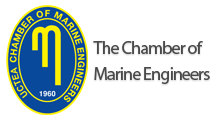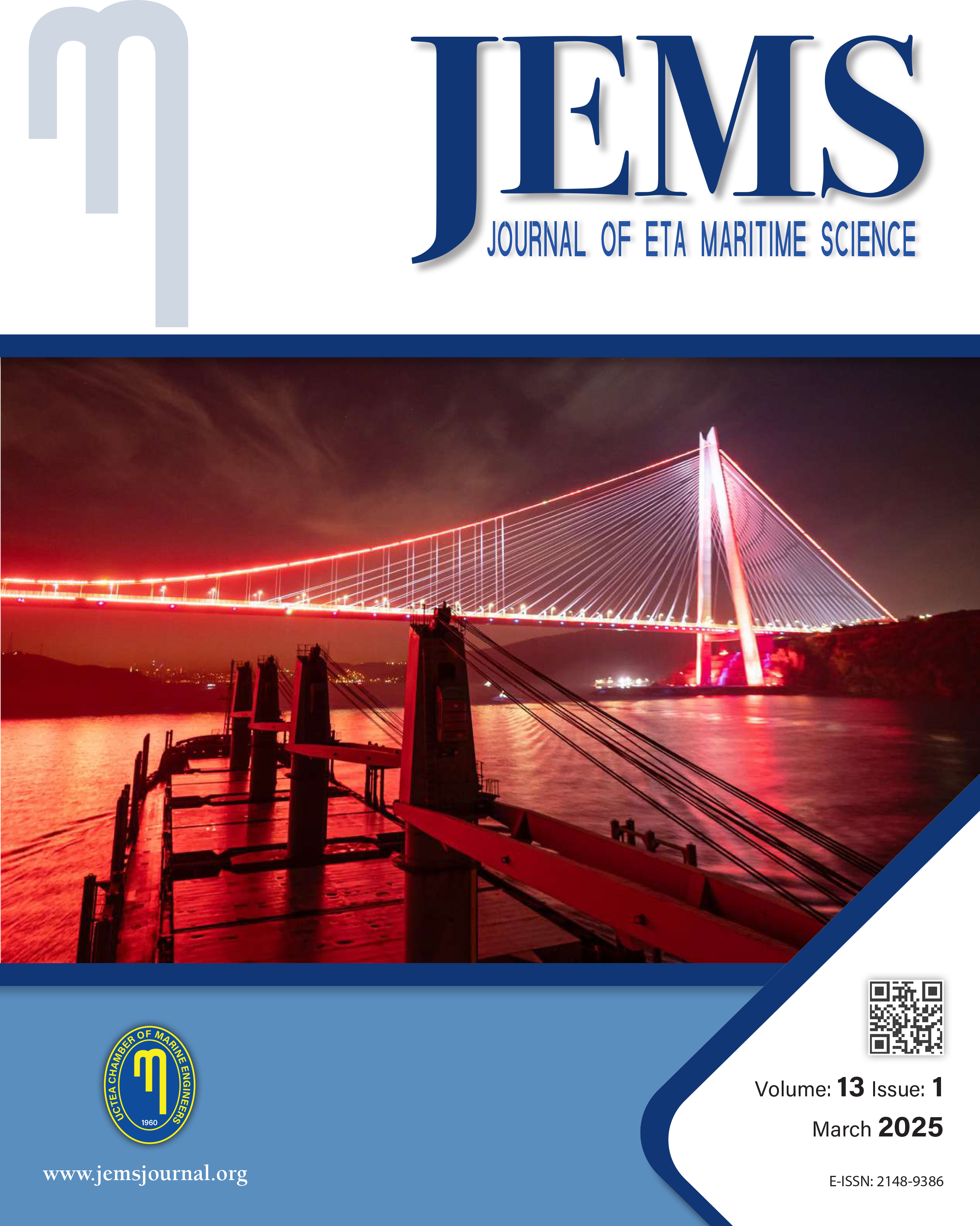

JEMS apply the Creative Commons Attribution NonCommercial 4.0 International Licence to all manuscripts to be published
ABSTRACTING & INDEXING
Volume: 8 Issue: 4 - 2020
| EDITORIAL (ED) | |
| 1. | Editorial Selçuk Nas doi: 10.5505/jems.2020.53254 Page 213 Abstract | |
| FULL TEXT | |
| 2. | Journal of ETA Maritime Science (Volume: 8 Issue: 4, 2020). Pages 213 - 308 Abstract | |
| REVIEW (RE) | |
| 3. | Dimensions of the Port Performance: A Review of Literature Umur Bucak, İbrahim Müjdat Başaran, Soner Esmer doi: 10.5505/jems.2020.76598 Pages 214 - 240 The port performance has frequently been studied in the academic literature, and the first studies on the subject are focused on financial or operational dimensions. However, today, port performance has become multi-dimensional due to the changing roles of the ports to its stakeholders, and the fact that local competition has been replaced by global competition through continuously developing routes, etc. Within this study, it is aimed to determine each dimension of the port performance concept which had been handled as a multi-dimensional process in recent years in literature. For this purpose, port performance literature is reviewed and frequency analysis of the related studies was made. As a result of the analysis, dimensional perspective was brought to the port performance concept and the indicators of each dimension used in empirical studies were gathered together. So, the concept of port performance had been divided into four basic dimensions which are operational, financial, sustainable, and logistics. Finally, dimensional gaps in port performance literature were revealed and some suggestions were given for further studies. |
| ORIGINAL RESEARCH (AR) | |
| 4. | Risk-based Analysis of Pressurized Vessel on LNG Carriers in Harbor Thaddeus Chidiebere Nwaoha, Sidum Adumene doi: 10.5505/jems.2020.89266 Pages 242 - 251 The need to understand the associated risks of pressurized vessels and their consequences onboard ship is imperative. The handling and storage of Liquefied Natural Gas (LNG) mostly result in catastrophic accident with associated consequences. To quantify these consequences in terms of death and degree of burn depends on the tank structures and pressure control mechanism onboard LNG carriers in a harbor. In this research, the result of the potential risks and damage consequences of the LNG fire accident in terms of the degree of burns and fatality is presented. The probability of death, first and second degree of burn injuries are assessed using consequence modelling technique, while the pool fire was modelled using the Boiling Liquid Expanding Vapour Explosion (BLEVE) approach. The result shows that at 30 meters from the flame radius, the probabilities for first-degree burn, second-degree burn, and death decrease, respectively. A sensitivity analysis revealed that at the initial heat flux and closer distance of 5m to 10m from the flame radius at the point of the accident, the death rate, first degree, and second-degree burns increase significantly. Therefore, installing a safety system and best practices that will mitigate these risks to as low as reasonably possible should be incorporated into the system design. |
| 5. | Weighting Key Factors for Port Congestion by AHP Method Pelin Bolat, Gizem Kayisoglu, Emine Gunes, Furkan Eyup Kızılay, Soysal Ozsogut doi: 10.5505/jems.2020.64426 Pages 252 - 273 Port congestion is one of the most important factors for measuring port performance and a critical problem that affects seaports' performance, productivity and efficiency levels as well. Determining the most important factors affecting the port congestion in detail contributes to the economic and social growth of the ports. This paper makes an effort to contribute to the existing literature by determining importance weights of factors leading to port congestion as the unique study on the matter. Therefore, it is aimed to identify the most important factors on port congestion according to the port state control, flag state control and independent surveyors points of views. For this purpose, a literature research was conducted on the factors causing port congestion and experts on the field were consulted. Then the collected data were classified in a list and the determined factors have been ordered with Analytic Hierarchy Process method by experts. The importance weights of the factors have been identified and the most significant factors for port congestion have been obtained with the pairwise comparison of the criteria. According to the results, it can be argued that the most important main factors for port congestion are documentation procedures, port operation and management, ship traffic inputs, port structure and strategy and government relations, respectively. |
| 6. | Simulation-Based Optimization of the Sea Trial on Ships Yusuf Genç, Murat Ozkok doi: 10.5505/jems.2020.93898 Pages 274 - 285 As well known, ships which have complex production processes are subject to various tests made on every stage in many fields from the beginning to the end of the production. After the tests are completed successfully, the ship is delivered to the ship-owner. Sea trial being the last stage of these tests, is examined in detail in this study. The purpose of this study is to plan the tests performed in the sea trial by the means of computer programs and to suggest shorter completion period for the tests.Thus, reducing the total cost ofthe cruising. Moreover, shortening the duration ofthe cruise will be a factor that can speed up the delivery ofthe ship. For this purpose, the tests and processes performed during the sea trial are listed. A cruise process flow diagram including all the tests applied under normal conditions was created, and the data were entered into the SIMIO simulation program. As a result, it was determined that the total cruising time was 28,0989 hours. After that, a new flow diagram was created by making some improvements in the current testing process, and a new simulation model was built up. In the new simulation model, total time spent to complete the tests were 25,3567 hours, so the testing time was shortened by 2.75 (9,76%) hours. |
| 7. | Measurement and Modelling of Particulate Matter Emissions from Harbor Activities at a Port Area: A Case Study of Trabzon, Turkey Süleyman Köse doi: 10.5505/jems.2020.49389 Pages 286 - 301 Due to the versatile activities caused by the services provided at the harbor, a large amount of particulate matter is emanated. The health of living things is seriously threatened by the spread of these substances in the air due to the effect of many environmental factors. The size of this threat may reach much higher levels, especially at ports located close to city centers.In this study, atthe Trabzon Port area, PM10 and PM (deposited dust) measurements from the harbor activities were carried out at 9 different points between February 2019 and April 2019 and the dispersion of these particulate matter into the environment is analyzed utilizing the ISCST3 (Industrial Source Complex - Short Term) model program. It is detected that the highest amount of measured PM10 (suspended particulate matter) is at the dock 3 with 1.84 mg/Nm3 and the highest amount of PM (deposited dust) is in the dock loading area with 203 mg/m2 -day. In the modelling study, it is determined that the particulate matter disperse around an area of 25 km2 in the south direction of the port, and it is concluded that port air quality management will focus on precautions for docks where intensive loading-unloading activities take place. |
| TECHNICAL REPORT (RP) | |
| 8. | Is Existing Maintenance System Adequate for Sulphur 2020 Amendments? Ahmet Yaşar CANCA, Görkem Kökkülünk doi: 10.5505/jems.2020.89421 Pages 302 - 308 Sulphur 2020 regulation as a reduction of sulphur emissions has been caused a big challenge via using new fuels in the maritime industry. Consistent changes in the chemical and physical properties of these new fuels make classical maintenance methods as brake down or planned inadequate and endanger operational and navigational safety on ships. Within this framework, ship maintenance systems need to be reevaluated in accordance with the new marine fuels. In this study, firstly impacts of new marine fuels on ships have been evaluated by means of a literature review. Furthermore, repair and maintenance systems have been presented that are currently used on board ships. Subsequently, advantages of a predictive maintenance system that will reduce risk by constantly monitoring the potential critical characteristics of VLSFO over other maintenance systems have been discussed. Then, assessments of compliance fuel have been done in accordancewith fuel properties, problems and corrective actions. Lastly, discussions and suggestions have been provided to the ship owners and technical managements. |










